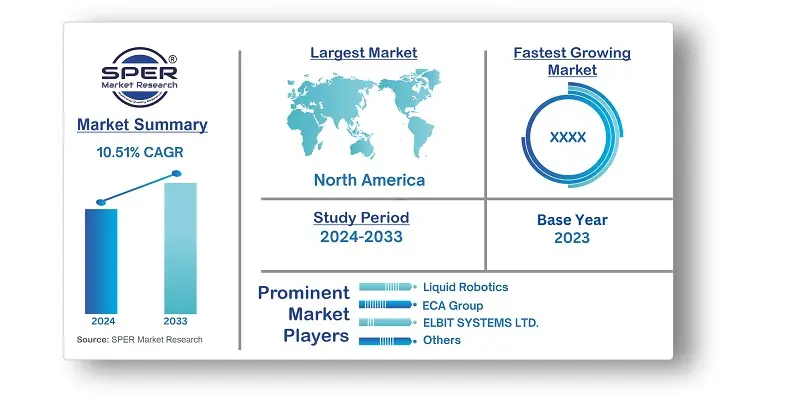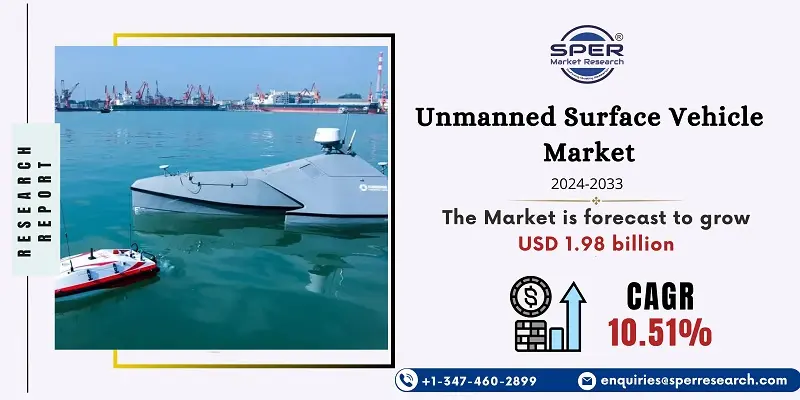
Unmanned Surface Vehicle Market Growth, Size, Trends, Demand, Share and Future Outlook
Unmanned Surface Vehicle Market Size- By Size, By Application, By Mode of Operation- Regional Outlook, Competitive Strategies and Segment Forecast to 2033
| Published: Apr-2024 | Report ID: AMIN24119 | Pages: 1 - 232 | Formats*: |
| Category : Automotive & Transportation | |||
- March 2022: Kongsberg Maritime is happy to announce the release date of the EM 712 USV, a new multibeam echosounder designed for use with unmanned surface vehicles (USV), which is set for March 2022. The newest member of KM's industry-leading EM 712 series of multibeam echosounders for seabed mapping applications in shallow to medium water.
- Feb 2022: The DE&S Mine Hunting Capability (MHC) Team and ATLAS Elektronik UK signed a contract in February 2022 for the delivery of the ARCIMS unmanned surface vessel mine hunting system to the UK Royal Navy.


| Report Metric | Details |
| Market size available for years | 2020-2033 |
| Base year considered | 2023 |
| Forecast period | 2024-2033 |
| Segments covered | By Size, By Application, By Mode of Operation |
| Regions covered | North America, Asia-Pacific, Latin America, Middle East & Africa and Europe |
| Companies Covered | Liquid Robotics, Kangsberg Maritime AS, L3Harris Technologies,Inc., ECA Group, Atlas Elektronik GmbH, ELBIT SYSTEMS LTD., SeaRobotics Corp., Teledyne Technologies Incorporated, Israel Aerospace Industries, Maritime Robotics. |
- Fisheries and Aquaculture
- Oil and Gas Sector
- Government and Military Agencies
- Maritime Industry
- Research and Academia
- Technology Providers and Manufactures
- Regulatory Agencies
- Environmental Agencies
- Media and Communication
| By Size: |
|
| By Application: |
|
| By Mode of Operation: |
|
- Global Unmanned Surface Vehicle Market Size (FY’2024-FY’2033)
- Overview of Global Unmanned Surface Vehicle Market
- Segmentation of Global Unmanned Surface Vehicle Market By Size (Less than 11 Meters, 11-26 Meters, More than 26 Meters).
- Segmentation of Global Unmanned Surface Vehicle Market By Application (Defense, Commercial).
- Segmentation of Global Unmanned Surface Vehicle Market By Mode of Operation (Autonomous Surface Vehicle, Remotely Operated Surface Vehicle)
- Statistical Snap of Global Unmanned Surface Vehicle Market
- Expansion Analysis of Global Unmanned Surface Vehicle Market
- Problems and Obstacles in Global Unmanned Surface Vehicle Market
- Competitive Landscape in the Global Unmanned Surface Vehicle Market
- Impact of COVID-19 and Demonetization on Global Unmanned Surface Vehicle Market
- Details on Current Investment in Global Unmanned Surface Vehicle Market
- Competitive Analysis of Global Unmanned Surface Vehicle Market
- Prominent Players in the Global Unmanned Surface Vehicle Market
- SWOT Analysis of Global Unmanned Surface Vehicle Market
- Global Unmanned Surface Vehicle Market Future Outlook and Projections (FY’2024-FY’2033)
- Recommendations from Analyst
1.1. Scope of the report1.2. Market segment analysis
2.1. Research data source2.1.1. Secondary Data2.1.2. Primary Data2.1.3. SPER’s internal database2.1.4. Premium insight from KOL’s2.2. Market size estimation2.2.1. Top-down and Bottom-up approach2.3. Data triangulation
4.1. Driver, Restraint, Opportunity and Challenges analysis4.1.1. Drivers4.1.2. Restraints4.1.3. Opportunities4.1.4. Challenges4.2. COVID-19 Impacts of the Global Unmanned Surface Vehicle Market.
5.1. SWOT Analysis5.1.1. Strengths5.1.2. Weaknesses5.1.3. Opportunities5.1.4. Threats5.2. PESTEL Analysis5.2.1. Political Landscape5.2.2. Economic Landscape5.2.3. Social Landscape5.2.4. Technological Landscape5.2.5. Environmental Landscape5.2.6. Legal Landscape5.3. PORTER’s Five Forces5.3.1. Bargaining power of suppliers5.3.2. Bargaining power of buyers5.3.3. Threat of Substitute5.3.4. Threat of new entrant5.3.5. Competitive rivalry5.4. Heat Map Analysis
6.1. Global Unmanned Surface Vehicle Market Manufacturing Base Distribution, Sales Area, Product Type6.2. Mergers & Acquisitions, Partnerships, Product Launch, and Collaboration in Global Unmanned Surface Vehicle Market
7.1. Global Unmanned Surface Vehicle Market Value Share and Forecast, By Size, 2024-20337.2. Less Than 11 Meters7.3. 11-26 Meters7.4. More than 26 Meters
8.1. Global Unmanned Surface Vehicle Market Value Share and Forecast, By Application, 2024-20338.2. Defense8.3. Commercial
9.1. Global Unmanned Surface Vehicle Market Value Share and Forecast, By Mode of Operation, 2024-20339.2. Autonomous Surface Vehicle9.3. Remotely Operated Surface Vehicle
10.1. Global Unmanned Surface Vehicle Market Size and Market Share
11.1. Global Unmanned Surface Vehicle Market Size and Market Share By Size (2020-2026)11.2. Global Unmanned Surface Vehicle Market Size and Market Share By Size (2027-2033)
12.1. Global Unmanned Surface Vehicle Market Size and Market Share By Application (2020-2026)12.2. Global Unmanned Surface Vehicle Market Size and Market Share By Application (2027-2033)
13.1. Global Unmanned Surface Vehicle Market Size and Market Share By Mode of Operation (2020-2026)13.2. Global Unmanned Surface Vehicle Market Size and Market Share By Mode of Operation (2027-2033)
14.1. Global Unmanned Surface Vehicle Market Size and Market Share By Region (2020-2026)14.2. Global Unmanned Surface Vehicle Market Size and Market Share By Region (2027-2033)14.3. Asia-Pacific14.3.1. Australia14.3.2. China14.3.3. India14.3.4. Japan14.3.5. South Korea14.3.6. Rest of Asia-Pacific14.4. Europe14.4.1. France14.4.2. Germany14.4.3. Italy14.4.4. Spain14.4.5. United Kingdom14.4.6. Rest of Europe14.5. Middle East and Africa14.5.1. Kingdom of Saudi Arabia14.5.2. United Arab Emirates14.5.3. Rest of Middle East & Africa14.6. North America14.6.1. Canada14.6.2. Mexico14.6.3. United States14.7. Latin America14.7.1. Argentina14.7.2. Brazil14.7.3. Rest of Latin America
15.1. Liquid Robotics15.1.1. Company details15.1.2. Financial outlook15.1.3. Product summary15.1.4. Recent developments15.2. Kangsberg Maritime AS15.2.1. Company details15.2.2. Financial outlook15.2.3. Product summary15.2.4. Recent developments15.3. L3Harris Technologies,Inc.15.3.1. Company details15.3.2. Financial outlook15.3.3. Product summary15.3.4. Recent developments15.4. ECA Group15.4.1. Company details15.4.2. Financial outlook15.4.3. Product summary15.4.4. Recent developments15.5. Atlas Elektronik GmbH15.5.1. Company details15.5.2. Financial outlook15.5.3. Product summary15.5.4. Recent developments15.6. ELBIT SYSTEMS LTD.,15.6.1. Company details15.6.2. Financial outlook15.6.3. Product summary15.6.4. Recent developments15.7. SeaRobotics Corp.,15.7.1. Company details15.7.2. Financial outlook15.7.3. Product summary15.7.4. Recent developments15.8. Teledyne Technologies Incorporated15.8.1. Company details15.8.2. Financial outlook15.8.3. Product summary15.8.4. Recent developments15.9. Israel Aerospace Industries15.9.1. Company details15.9.2. Financial outlook15.9.3. Product summary15.9.4. Recent developments15.10. Maritime Robotics15.10.1. Company details15.10.2. Financial outlook15.10.3. Product summary15.10.4. Recent developments15.11. Others
SPER Market Research’s methodology uses great emphasis on primary research to ensure that the market intelligence insights are up to date, reliable and accurate. Primary interviews are done with players involved in each phase of a supply chain to analyze the market forecasting. The secondary research method is used to help you fully understand how the future markets and the spending patterns look likes.
The report is based on in-depth qualitative and quantitative analysis of the Product Market. The quantitative analysis involves the application of various projection and sampling techniques. The qualitative analysis involves primary interviews, surveys, and vendor briefings. The data gathered as a result of these processes are validated through experts opinion. Our research methodology entails an ideal mixture of primary and secondary initiatives.



Frequently Asked Questions About This Report
PLACE AN ORDER
Year End Discount
Sample Report
Pre-Purchase Inquiry
NEED CUSTOMIZATION?
Request CustomizationCALL OR EMAIL US
100% Secure Payment






Related Reports
Our Global Clients
Our data-driven insights have influenced the strategy of 200+ reputed companies across the globe.




















